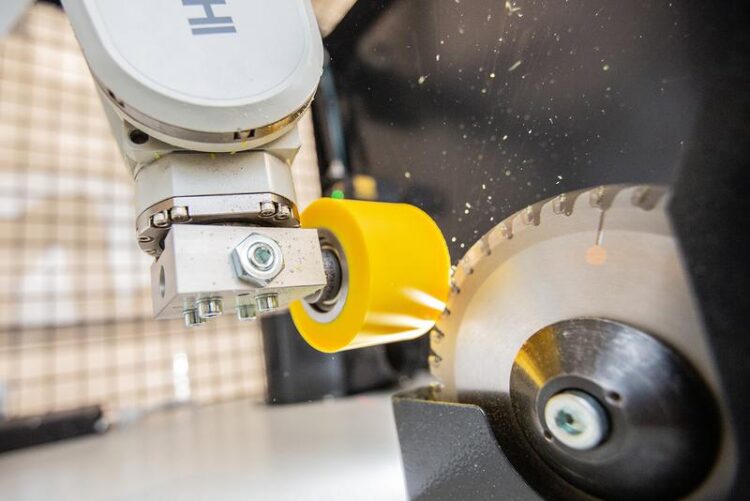Artificial intelligence – but please be trustworthy!

The grinding process
© Fraunhofer IEM
The grinding process
To date, entrepreneurs have not put a lot of trust in artificial intelligence – many processes are still performed manually. An example of how artificial intelligence and control technology can be combined to create a completely trustworthy system is RoboGrinder: A grinding machine developed by the Fraunhofer Institute for Mechatronic Systems Design IEM, which eliminates up to 40 percent of grinding processes. It can be seen at the joint Fraunhofer booth at the Hannover Messe 2022 from May 30 to June 2 (Hall 5, Booth A06).
Companies often have a hard time with artificial intelligence: They are concerned that they will end up with a solution which is not always reliable – and therefore often continue to perform tasks, especially those of a complex nature, manually. Fraunhofer IEM researchers have set themselves the goal of countering this skepticism and boosting confidence in artificial intelligence. “We combine the tried and true – control technology – with the new – artificial intelligence,” explains Steven Koppert, Group Manager of Trusted Machine Intelligence at Fraunhofer IEM. “While much of control technology is based on physical and mathematical models that can be analyzed and trusted, artificial intelligence – which in itself is not particularly trustworthy at first – usually relies exclusively on data and also solves creative tasks. Combine these two approaches and you get a flexible, trustworthy system – also known as trusted machine intelligence.”
RoboGrinder: An intelligent grinding machine
What that means exactly can be best explained by an example: The RoboGrinder. At Düspohl, a mechanical engineering company, the grinding process for the rubber-like rollers that press films against the component when applying them to window frames or baseboards is being automated for the first time. Until now, these rollers, which are known as profile wrapping rollers and tend to have a complex shape, have been ground by hand. This is because automation using control technology alone is not readily feasible for the rubber-like material. Ultimately, this is based on a target/actual comparison and grinds away all excess material. The problem: The roller material is so elastic that it springs back after grinding – a behavior that is very difficult to model and integrate into a control technology approach. This means that numerous grinding processes are required – but the closer the target, the more inefficient the process becomes. Also, the quality of the surface can deteriorate with the number of grinding processes. “We document any grinding errors that occur during each grinding process and use it to train an artificial intelligence model – so the AI takes over the correction, especially during fine adjustments,” says Koppert. “Comparatively, you could say that control technology serves as a crash barrier, while artificial intelligence ensures that the curve of the road is negotiated in the best possible way.” In this way, the process can be reliably automated for the first time. For profile-sheathing companies in the building component and furniture industry this means they can reproduce spare parts at their own plant within minutes. Not much space is needed for this; the prototype measures just one by two meters. “Using our machines, our customers from the building components and furniture industry produce a wide range of different models and components. At the same time, they must be able to react quickly and easily to the circumstances of new orders. The intelligent grinding system would therefore be a major building block for automation,” says Uwe Wagner, Managing Director of Düspohl.
Reducing grinding processes by up to 40%
The researchers at Fraunhofer IEM initially mapped out the grinding process digitally. The result: RoboGrinder can eliminate 15 percent of grinding operations when regrinding from the approximate to the specified size. The advantage becomes even clearer when regrinding used rolls, where the grinding process takes place directly on the sensitive area – which means regrinding must be performed extremely carefully so as not to remove too much material. “Using the digital twin, we were able to show that we can eliminate up to 40 percent of the grinding process,” says Koppert. Other advantages of RoboGrinder: The specified size is guaranteed, the shape of the workpiece is detected independently by a laser scanner and the machining process is configured automatically. The setup time is also unique: It only takes a few moments to go from planning to completion.
Researchers are currently conducting parameter studies and working on issues relating to construction, among other things. The first prototypes of RoboGrinder will be at the Hannover Messe from May 30 to June 2, 2022 (Hall 5, Booth A06). This should be of interest to all companies that want to automate manual processes in a trustworthy manner, but where this is not possible using standard automation technology. After all, the methodology developed to create trustworthy artificial intelligence is universally applicable.
Weitere Informationen:
https://www.fraunhofer.de/en/press/research-news/2022/may-2022/artificial-intell…
Media Contact
All latest news from the category: Information Technology
Here you can find a summary of innovations in the fields of information and data processing and up-to-date developments on IT equipment and hardware.
This area covers topics such as IT services, IT architectures, IT management and telecommunications.
Newest articles

Silicon Carbide Innovation Alliance to drive industrial-scale semiconductor work
Known for its ability to withstand extreme environments and high voltages, silicon carbide (SiC) is a semiconducting material made up of silicon and carbon atoms arranged into crystals that is…

New SPECT/CT technique shows impressive biomarker identification
…offers increased access for prostate cancer patients. A novel SPECT/CT acquisition method can accurately detect radiopharmaceutical biodistribution in a convenient manner for prostate cancer patients, opening the door for more…

How 3D printers can give robots a soft touch
Soft skin coverings and touch sensors have emerged as a promising feature for robots that are both safer and more intuitive for human interaction, but they are expensive and difficult…





















